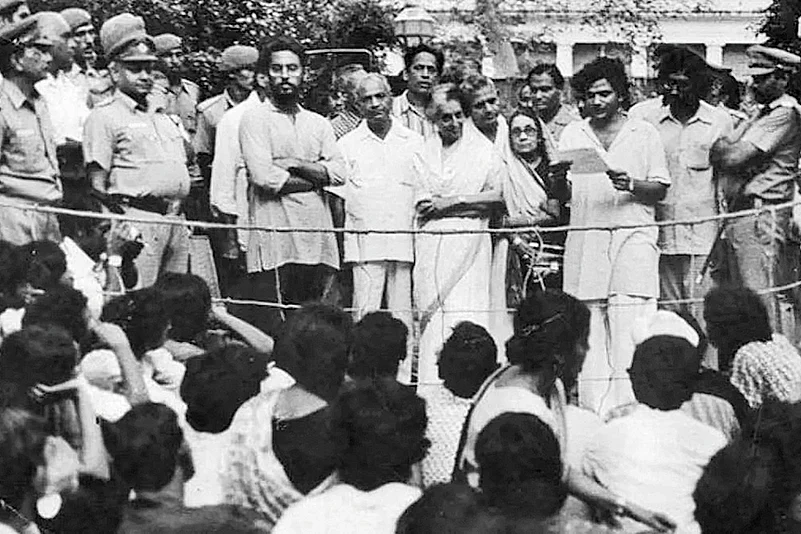This article was published in the Outlook magazine issue 'Emergency: The Legacy/The Lunacy' dated October 1, 2024. To read more article from the issue, click here.
The death of Sitaram Yechury threw up a black-and-white photo of him in 1977, reading an indictment of Indira Gandhi in her presence. In that photo, Yechury, the president of the Jawaharlal Nehru University (JNU) Students’ Union at the time, is asking that she resign as chancellor of the university because she had lost the post-Emergency general election, and she held that honorary office by virtue of being the prime minister of India. Yechury had been jailed during the Emergency and this black-and-white picture of a tousled student leader in an oversized kurta-pyjama, publicly holding a prime minister to account as she looks on, smiling, seems an image from another country… the safely distant past.
I was 20 when that photo was taken, five years younger than Yechury and much too prudent to have risked imprisonment through my second and third years as an undergraduate in Delhi University, but I remember the sense of release when All India Radio announced in an evening broadcast that the Congress (I) had lost the election, and Gandhi, her seat. I was living in Delhi University at the time, with my aunt, who was a lecturer there. When I relayed the news, she was still for a moment. Hai bechari (poor thing), she said, and went back to combing her hair.
For her and my parents’ generation, Indira was still Panditji’s daughter. Even as they were oppressed by her authoritarianism, she remained a living reminder of the early promise of the republic. I was nine years old when she became prime minister. My generation was defined by her time at the top, from 1966 when she succeeded Lal Bahadur Shastri when he died unexpectedly in Tashkent, to 1984 when she was assassinated. My cohort’s understanding of the purpose of the Indian state and India’s place in the world, our idea of India was either constituted by her government’s rhetoric or shaped by our opposition to it.
My earliest memory of political clientage is the photograph of V V Giri and his wife on the front page of The Statesman the day after he was elected president in 1969. It was taken in extreme close-up with Giri flashing a ‘V’ sign and grinning, rictus-like, into the camera, a distinguished man who had swapped dignity for preferment. It’s been taken for granted for decades now that the president of India isn’t just a constitutional figurehead, but also a creature of the prime minister who appoints him. This wasn’t true till the end of the 1960s. Rajendra Prasad, Sarvepalli Radhakrishnan and Zakir Husain were notably independent-minded men. Giri, who owed his election to the support of Gandhi, pioneered the role of the rubber-stamp president.
From this distance in time, we sometimes forget how popular Gandhi’s signature policy initiatives were at the time with the sarkari salariat that was such an influential part of the Indian middle class. I was in middle school when she nationalised the banks and set about abolishing the princes’ privy purses. I had, unsurprisingly, no interest in national politics; the only public event that consumed me in 1969 was the moon landing in July that year.
But when Gandhi’s bid to abolish the privy purses failed by a single vote in the Rajya Sabha, she tried to finesse this failure by abolishing them via a presidential order, issued by the pliable Giri. When the Supreme Court struck that down, my Class VII teacher organised a classroom debate on the issue. Taking my cue from my parents, I made the case for abolition; why pamper the princes when the money could be better spent feeding people starving to death in Maharashtra because of the drought? Warun, my opponent, made a scrupulous constitutional case for honouring the commitments the republic’s founders had made while integrating the princely states. It was a first-rate argument, worthy of Nani Palkhivala, but I (and the people) won. It was an early instance of the rhetorical power of Gandhi’s populism.
The zenith of her populist fame, her annus mirabilis, was 1971. She abolished the privy purses via a constitutional amendment, won the general election on the back of the slogan Garibi Hatao! (itself a neat inversion of the opposition’s slogan, Indira Hatao!), and then played a masterly geopolitical hand to rout Pakistan in the war for Bangladesh, thumb her nose at Nixon and his Seventh Fleet and capture more than 90,000 Pakistani POWs. Atal Bihari Vajpayee hailed her as Ma Durga for defeating and dividing Pakistan. More secular-minded Indians celebrated the creation of Bangladesh as proof that the ‘Two Nation Theory’ had been proved wrong, that religion was not a stable basis for nationhood.
It was downhill after that. The oil shock of 1973 and the economic instability that beset India in those years led to the student unrest that morphed into a more general discontent harnessed by Jayaprakash Narayan and used as an alibi by Gandhi for proclaiming the Emergency.
I remember the day it happened. I was in the middle of the summer vacation after my first year in college. We lived in Rabindra Nagar, next to Khan Market, which was a sleepy collection of shops made up of mithai ki dukans, chemists, ‘dairies’ and bookstores.
We lived there because my mother’s job, as an acoustical engineer with All India Radio, came with the perk of government accommodation. She called in the afternoon of that hot day in June to tell me that something important had happened. She wouldn’t say what it was over the phone. “Turn on the radio,” she said enigmatically. It was remarkable how quickly middle-class Indians, citizens of the world’s largest democracy for nearly 30 years at the time, learnt docility and discretion.
Gandhi’s principal legacy from that moment on was the systematic replacement of institutional governance with the vicious precedents of personalised rule. I can see her on Doordarshan still, in black-and-white, ranting at bussed-in crowds in her brutish Hindi, scattering tenses like promissory notes (hum karenge, humein karna hai), the white streak in her hair growing and shrinking like a living thing. We are lucky that she found a novelist who encompassed her grotesqueness; Salman Rushdie’s Midnight’s Children is the most vivid realisation of that deranged caudillo moment that you could hope to have. Ironically, it was published the year after Gandhi returned to power with the collapse of the Janata Party government.
Her paradoxical achievement was to corrupt everything that brought her to power and kept her there. She reduced India’s grand old party, the Congress, into a dynastic cult of personality. She debased the terms she used to shore up her image—socialism, secularism, non-alignment—till they meant nothing. Her younger son’s sterilisation drives, the godmen, the lumpenisation of Congress politics, the patronage extended to sectarians like Bal Thackeray and Jarnail Singh Bhindranwale to achieve provincial political ends, created the thuggish milieu and the majoritarian mindset that prepared the ground for the Sangh Parivar’s violent ascent.
Gandhi’s final term in office saw riots and pogroms in Moradabad, Bihar Sharif, Baroda, Nellie, Hyderabad and Bhiwandi. I was in my 20s then, and it was hard to even recognise the woman hailed by her compatriots in 1971. She had turned into a paranoid virago who ran a party made up in equal parts of placemen and lumpen. The horrific pogrom of Sikhs in Delhi in 1984 after her assassination was the coming together of two things: the majoritarian violence that had become routine on her watch and the culture of thuggish violence that had become the currency of Congress politics in Delhi and beyond. The things men and women my age saw in Kalyanpuri and Trilokpuri in the course of the Congress-led killings after the assassination, marked us forever.
It turned my sliver of desi bien pensants off the Congress for a generation. I remember marching past Shastri Bhawan in procession chorusing ‘Dilli ki galiyan sooni hain, Congress (I) khooni hain’ (Delhi’s lanes are echoingly silent/The Congress (I) is bloody and violent). The long ascent of the Sangh Parivar after her son’s killing led to a revaluation, as my cohort tried to parse the lesser evil.
MORE FROM THIS ISSUE
A history of Gandhi’s time in office as history and not polemic, remains to be written. It will be written but not by my contemporaries because it is impossible for people who lived that time to write about it with the requisite distance. For us, it will always be a reckoning. But somewhere in the multiverse, there is a better version of India where Gandhi dies peacefully at her desk in 1 Safdarjung Road, after conjuring Bangladesh into being in 1971.
(Views expressed are personal)






























